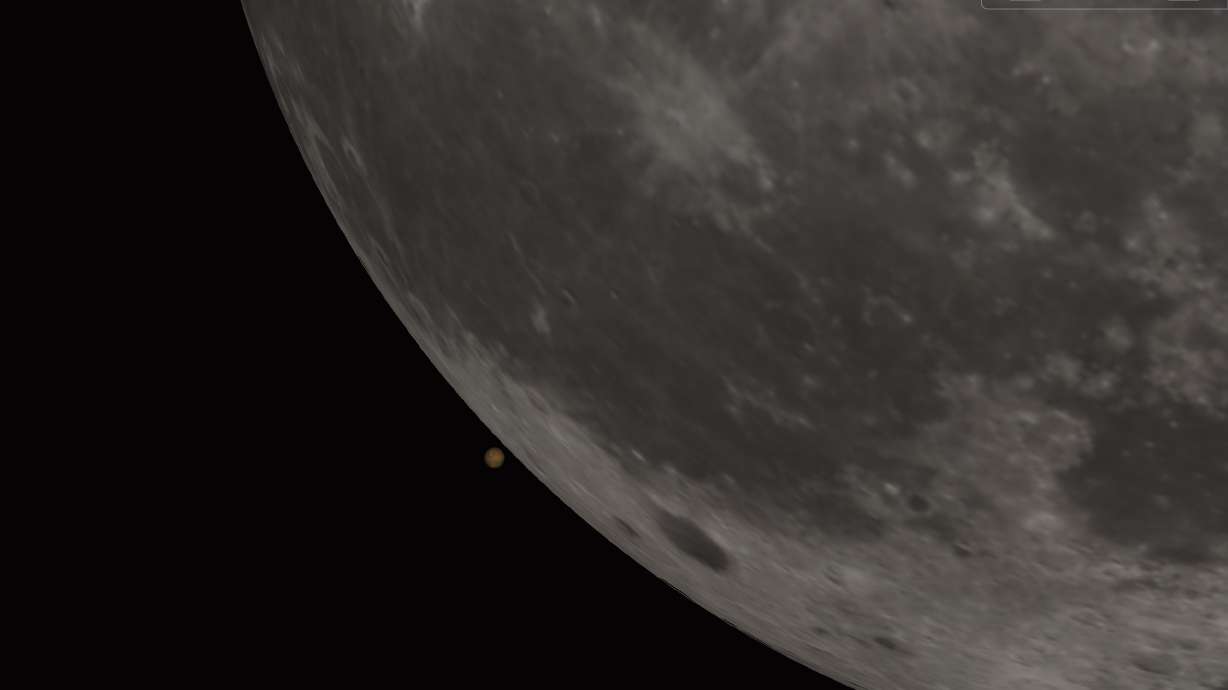Estimated read time: 4-5 minutes
This archived news story is available only for your personal, non-commercial use. Information in the story may be outdated or superseded by additional information. Reading or replaying the story in its archived form does not constitute a republication of the story.
SALT LAKE CITY — Look to the skies this week to witness the occult — a lunar occultation of the planet Mars, that is.
Beginning Wednesday night, the moon will slowly inch up towards Mars, until about 7:40 pm, when it will overtake the red planet, completely covering it for about 70 minutes, until Mars reappears on the other side.
No nightmare before Christmas, this is a novel astronomical event accessible to stargazers of all abilities. It's a sight that will be visible to naked-eye stargazers since Mars is at its brightest in its roughly 26-month rendezvous cycle with Earth and you can't miss the nearly-full moon. The view gets even better if you can view the visible obstruction with binoculars or a telescope.
Kevin Poe, the owner and operator of Dark Ranger Telescope Tours hopes Utahns won't fear the event's eerie name and will venture out to take a look.
"Whatever you do, don't hide in your basement, because you don't want to miss this," he said.
Viewing the celestial vanishing act
A lunar occultation, according to the International Occultation Timing Association, occurs when the moon passes in front of another heavenly object.
University of Utah astronomer Paul Ricketts adds that this happens due to the motion of the moon. If you look close enough on any night, you can see the position of the moon change relative to the stars around it. With this motion, the moon will slip in front of Mars Wednesday night.
The exact time of the occultation varies based on location, according to earthsky.org. In Utah, this amounts to a difference of a few minutes, per in-the-sky.org; for example, it will be visible from 7:41 p.m. to 8:46 p.m. in Salt Lake City, or from 7:42 p.m. to 8:50 p.m. in Logan.
The timing is important. Ricketts said that if you get there late, you will miss the disappearance and need to wait an hour for the reappearance. While you can see this with your naked eye, you won't be able to view the "contact" Mars makes with the moon without the aid of large binoculars or a telescope, Ricketts added.
Yet this should not deter anyone from taking a gander.
"You can go literally to your backyard to see it, because (the moon and Mars) are two very bright objects," he said.
Poe, who will be at his observatory that is hosting a watch party Wednesday evening, said that at his position in southern Utah, Mars will enter and exit at about the center of the moon. What will this event look like through binoculars or a telescope?

"One of the best ways to (describe an occultation) is to call it a pimple," he said, drawing an analogy from dermatology. "What you'll see is the moon will have a bright, red-orange pimple, (which) eventually moves behind (the moon)."
Instead of popping, he continued, the Mars pimple will recede into the surface of the Moon as it disappears.
A rare event
Lunar occultations of various heavenly bodies happen fairly often, yet a Mars occultation visible in Utah is rare. Ricketts said he believes only a couple have happened in Utah in the past few decades. And, Poe said that Utah won't have another of this kind until 2059.
The moon will cut in front of Mars once again on Jan. 30, 2023; however, the full occultation will just barely miss Utah, according to in-the-sky.org. Poe expects to see this one from his vantage point near Bryce Canyon, a grazing occultation, where Mars skirts the edge of the moon. He sees a full occultation and grazing occultation happening in the same place during a short period of time — three lunar cycles — as even rarer.
Photographing the occultation is possible, said Ricketts, even with a phone placed up to a telescope.
"It's just a simple observation this time, something easy to look at," he said. "Pop outside and watch until you see (Mars) pop away behind the Moon."










